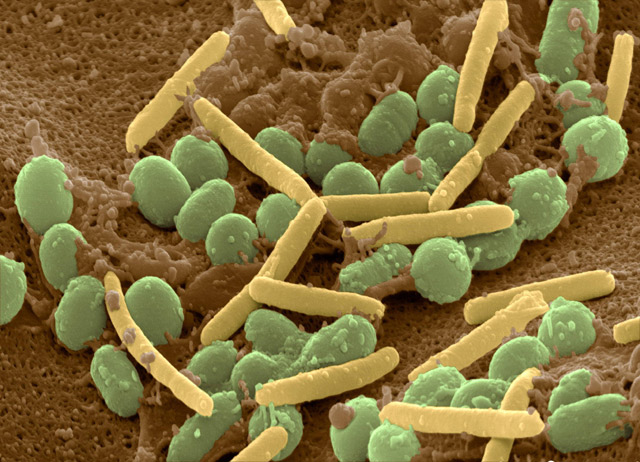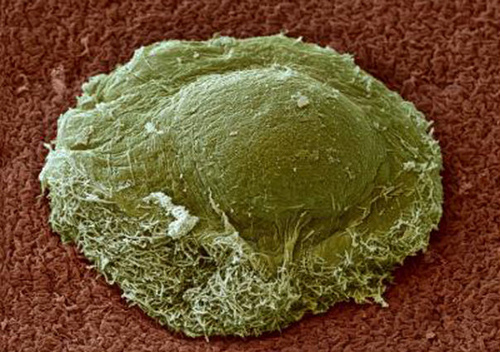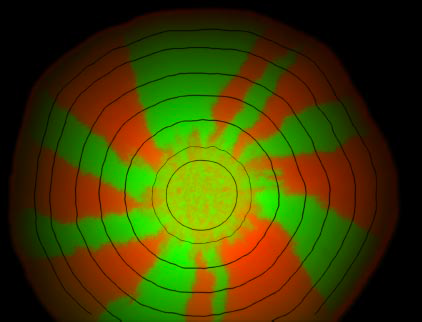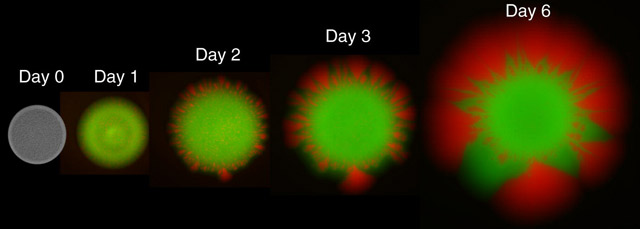Cooperation flourishes in the microbial world

Depending on the external conditions, the microbial Myxococcus xanthus can take both a competitive (yellow) form and a cooperative (green)
Despite the unicellular structure, microbes are capable of surprisingly cooperating with each other. They can secrete polymers that allow them to stick together and form biofilms to protect themselves from antibiotics and other poison. They can produce large amounts of lubricant, allowing colonies to grow on soft surfaces, and even produce molecules that hunt for iron in order to live in conditions of iron deficiency, for example, in humans.
This diversity of behavior raises questions about evolution: how can cooperation flourish in such a selfish environment, governed by natural selection? “The classic problem is that any cooperation will be costly from the point of view of individuals,” said Michael Desai , a physicist who has turned to microbiology evolutionary biologists at Harvard University. "The mystery is how could this situation arise as a result of evolution?"
A co-operation — by definition, a behavior that benefits someone else — can be, say, in the provision of food or protection, and usually for the giver. Especially in such rapidly mutated organisms as microbes, which regularly have new methods of deception that can surround the cooperators.
')

Yeast, capable of both deceiving and cooperating, allowed scientists to study the evolution of cooperation in microbes
According to the simplest model of natural selection, in a perfectly mixed population of cooperators and deceivers, the latter usually win. But theoretical calculations and experiments with microbes and other organisms have shown that cooperation can develop under certain conditions. Groups of related individuals working together are able to surpass deceivers, which explains that a myriad of organisms — microbes, insects, and even humans — can survive thanks to cooperation.
Two published studies have uncovered a new force that can help cooperators thrive: expanding the boundaries of the population. Both studies have worked with yeast, but scientists argue that the discoveries may be portable to other species, including humans. “It is not known how widespread this mechanism is, but it seems quite possible that it is quite widespread,” says Desai.
A better understanding of the conditions under which microbial cooperation originates can help in health-related research. Many human microbial organisms work in a cooperative mode known as biofilm, and new strategies that prevent the formation of biofilms can be alternatives to antibiotics, to which microbes can develop resistance. The discoveries can also shed light on the evolution of multicellular organisms that have emerged from sets of jointly acting cells, as well as cancer, which can be considered as a set of deceiver cells attacking the healthy and cooperative cells of our bodies
New territory
Most of the theoretical work on the evolution of cooperation focuses on static populations, either living in one place or maintaining a constant volume.

With a lack of food, thousands of individual Myxococcus xanthus cooperate and create an entity that produces spores.
Scientists have long known that spatial agreements of a static population can push germs to altruism. Although in highly heterogeneous groups of microbes the cheaters win, lumps of cooperating germs can distill in the amount of clumps of cheaters. Two popular and somewhat overlapping theories of the evolution of cooperation include the choice of relatives, according to which generosity towards family members helps one of the genes to survive, and the choice of the group, according to which the group of cooperating microbes succeeds more often than individual microbes. “The benefits of cooperation are not all members of the population, but only those who are either nearby or genetically similar,” Desai says.
But most species do not live in static conditions; they constantly undergo changes in quantity and change their habitat. Changes, for example, can trigger global warming and geological cycles, such as the ice age.
A new set of studies suggests that the expansion of the population can seriously affect the dynamics of evolution. In a growing population, random effects, more precisely called evolution of genes in evolutionary theory, may become more influential than natural selection. As a result, the number of thriving collaborating microbes groups may decrease.

When two strains of microbes (green and red) expand to a new territory, the strain likely to grow at the border will grow. The result is a turntable pattern, as in the photo.
In an experiment in 2007, the effect of expansion was demonstrated visually. Oskar Hallatschek, a biophysicist at the University of California at Berkeley, began with a drop of two well-mixed microbial strains painted in two colors with fluorescent dyes. As both strains grow at the same rate, the static population model predicts that their concentration will not change over time; the initial 50:50 ratio will continue. But the results were completely different. Microbes, starting to divide and spread on the Petri dish, quickly separated from each other and organized a “spinner” pattern with different sections of certain colors. “This is a very strong effect that is very difficult to avoid,” says Halachek.
The discoveries have become a terrific illustration of such a phenomenon as genetic surfing, theoretically predicted a few years earlier. (There are many physicists among researchers who are attracted, among other things, by the potential of modeling and testing evolutionary theories). In large static populations, the probability of fixation of new neutral mutations (which do not affect the suitability for evolution) is extremely low. But according to the surfing model, the probability of spreading mutations occurring on the border of a growing population is much higher - they sort of settle the expansion wave - and are strengthened because a small number of cells reproduce in that place. In a work from 2007, Halachek and his colleagues explained how genetic drift can fuel both genetic surfing and the appearance of the “spinner” pattern. Green bacteria divide and create more green colonies, causing a green wedge to grow. “In the case of an expanding colony, it’s all about the location,” says Halachek. “Even if you are a perfect mutant, you need to be exactly on this border to thrive, or you will not have chances.”
Khalachik’s experiments provided the first direct evidence that “surfing can dramatically change the diversity of neutral genes in a large natural population,” says Loren Exckoffie , a specialist in population genetics from the University of Bern in Switzerland who is not associated with research.
The discovery not only shows a striking contrast between static and spreading populations, but also the important role played by randomness in the evolution that occurred under suitable conditions. “It's all about multiplying the importance of chance,” says Kevin Foster , an evolutionary biologist at Oxford University who is not associated with this work. "This means that some properties, not even preferable to evolution, can become very common purely by chance."
Khalchek’s work “actually inspired a lot of research into understanding how natural selection and population expansion work, and what genetic traces they leave behind,” Desai says. - Our work continues this theme. We thought about the genetics of a growing population and realized that it leads to cooperation. ”
Little teamwork
Foster and colleagues suggested that expansion could be another force pushing for cooperation with the help of detailed computational modeling of microbes in 2010. The model confirmed the discoveries of Halachek and advanced them a step further, suggesting that expanding the boundaries of the population creates optimal conditions for cooperation between organisms.

In a mixed population of collaborating microbes (red) and deceptive microbes (green), co-operators end up winning
Recently, two groups of scientists have demonstrated this effect on real microbes, highlighting the special conditions by which they could evolve altruism. For the study of cooperation in yeast, the researchers used two types - the co-operators who isolated the enzyme that cleaved sucrose to the favorite food of microbes, glucose, and cheaters who could not do it. Almost all food produced by co-operators was released into the environment, where both co-operators and cheaters could enjoy it.
In the Desay experiment, published in the journal Current Biology , a drop of liquid containing both types of yeast was placed on a Petri dish. As the microbes dividing and expanding into unoccupied space, the deceivers and the co-operators occupied the border of the population at random. This led to a “founder effect”, with close-knit microbial groups living on the border. “Whoever was the first to migrate before the others, he also had more offspring,” Desai says.
As a rule, the population of collaborating yeast grew faster than the population consisting of individualist deceivers, since co-operators usually grew faster in a new territory. “They win at the border of the population, and as a result, the entire border is occupied by co-operators,” Desai says. “Spatial expansion of a population can drastically improve the chances for a successful evolution of cooperation.”
Dessay's microbes could grow in two dimensions, but some cases of expansion are one-dimensional — for example, birds moving along a chain of islands. Jeff Gore, a physicist at MIT, and colleagues analyzed the one-dimensional case, growing a mixture of cooperating and cheating microbes in thin fluid-filled tubes. They manually moved the germs, daily transferring some of the liquid to a new tube. Unlike Desai's cheating microbes, which are able to survive without cooperation, Goura's cheaters needed cooperatives for food and survival, and they penetrated into the growing population of cooperatives.

Jeff Gour
The researchers compared the speed of expansion of cooperatives at the border with the speed of reproduction of the cheaters who were behind. In order for the co-operators to succeed, they needed to expand faster than the fraudsters attacked them. The paper , published in Proceedings of the National Academy of Sciences, shows that in harsh conditions in a mixed population, co-operators spread and deceivers die. However, if both co-operators and cheaters develop in empty space, co-operators overtake cheaters only in mild, but not in harsh conditions. (The migration rate is calculated by measuring the population density of each of the tubes, which grows with time). “It's amazing how spatial expansion prefers cooperation — they seize new territories faster than deceivers can seize them,” says Gour.
Cooperators have preferential access to the fruits of their labors, as some of the enzymes secreted by them are stuck in their own cell walls. And this is important with a low cell density, because “in such conditions, the cells do not have enough sugar,” says Gour. “So co-operators can gobble up some of the total sugar before it dissolves.”
Foster says that spatial expansion is probably a necessary condition for the development of cooperation among microbes. "It is very simple, most likely universal, and explains one of the most important discoveries associated with microbes," he says.
In addition to microbes
Of course, microbes are not the only organisms that expand a population or manifest cooperation. In principle, the same factors that play a role for yeast can be applied to higher organisms, although scientists cautiously note that there is no evidence of this yet.
“It remains to be seen how widespread such an effect is in nature,” says Desai. Many species expand their territories, either seasonally or in the long term. Has the migration of people from Africa, tens of thousands of years, led to the emergence of preferences in favor of cooperation?
* * *
Expansion of people
An expanding population carries a characteristic genetic trait, and this trait has been found in humans. But the problem is that this sign is similar to the one that remains as a result of natural selection. People could migrate from Africa “for no apparent reason, perhaps simply because it was possible, but not necessarily because of some pressure from selection,” says Loren Exckofie, a population geneticist from the University of Bern. These discoveries suggest that it is impossible to conclude that only because of an increase in the frequency of mutations, that this occurs under the influence of natural selection. “In one set of experiments, they are trying to develop methods for separating these purely neutral effects of chance and real selection,” says Oscar Halachek.
Exsköfe and colleagues tried to study the effects of increasing human habitat by analyzing migration patterns of French-speaking Canadians in the 19th and 20th centuries. Thanks to detailed genealogical records, researchers could determine who and when changed their place of residence. According to the results published in 2011 in the journal Science, women at the border of the region of residence had 15% more children than others. "People who were on the crest of the propagation wave left more genes in the population than those in the middle of it," Excolfe says. "Therefore, people and bacteria are somewhat similar - individuals at the boundary of the habitat have more influence on the gene pool of future generations."
Records showed that border women were married a year earlier, which allowed them to have more children. And although the exact reasons for this are not clear, Exskofie believes that early marriages are caused by less competition at the border. “They were farmers, they had more resources than those who remained in the population center, where all the good places were already taken,” he says, so it was easier for men to provide for their wives.
* * *
“I don’t know the evidence that expansion of a habitat affects the cooperative style of human populations, but both of these studies indicate that, in principle, it can work to the benefit of cooperative behavior,” says Gour.
Foster is more skeptical about how much expansion affects cooperation. “It could have happened on a larger scale, but I'm not sure that the expansion of the population somehow promotes cooperation among non-microbial organisms,” he says. Social insects, another group of organisms that demonstrate a whole set of examples of cooperative behavior, “do everything completely differently,” he says. “With the growth of the colony, they do not show spatial expansion or genetic segregation.”
Understanding microbial cooperation can be important for other reasons, says Joa Xavier [Joao Xavier], a computational biologist at the Arch Center for them. Sloane-Kettering in New York. For example, the dynamics of spatial expansion could explain how dense tumors acquire the ability to spread through metastasis.
In a sense, cancer cells act like deceivers in a cooperative body. But the most successful cancers also work together. Cells that attract blood vessels to the tumor “act to the benefit of themselves and their neighbors,” says Xavier, a former chemical engineer who began studying how bacteria colonies can be used to purify water. "This is a cooperative property." Xavier, Foster, and their colleagues have already shown in simulations that the dynamics present in microbes can also be applied to cancer cells.
Foster says his team is starting to study more complex microbial colonies. Most laboratory studies are limited to one or two strains, but on our skin, or for example in the intestines, hundreds, or even thousands of species can play, playing scientists, we learned, a central role in human health. “Microbes are confronted not only with their fellow fraudsters, but also with a whole host of other bacteria and viruses,” says Foster. “If we want to manipulate or change the microbial community in the intestine or at the site of infection, we need to understand how they interact in order to understand how they will react.”
A growing set of scientific papers on spatial expansion leads to even darker questions: what happens when there is no place to grow? The answer depends on the circumstances. If resources run out, the entire population dies. If resources are enough, but there is no place to expand, then fraudulent strains begin to win. “When the population finishes expanding, cooperative phenotypes can die out, because their mechanism is completely dependent on expansion,” Desai says.
On the other hand, populations rarely stabilize completely. “In natural populations, cooperation is supported because of the frequent cases of expansion,” said Kirill Korolev , a physicist at Boston University, a colleague of Goura. “It is possible that large shakes occur periodically, such as wildfires, after which populations slowly recover.”
Source: https://habr.com/ru/post/402573/
All Articles